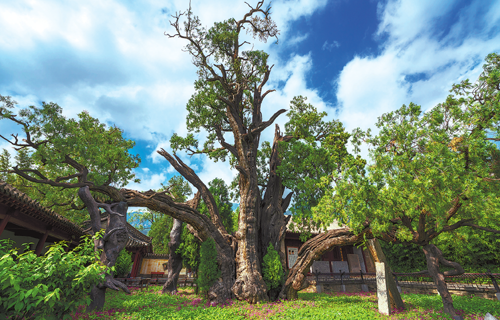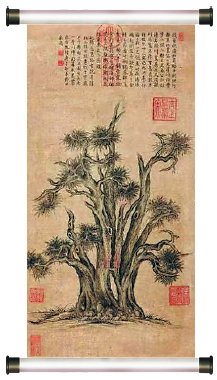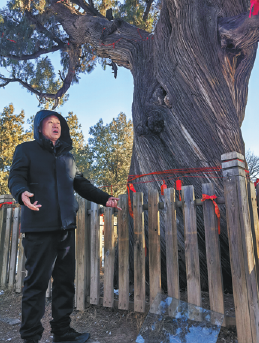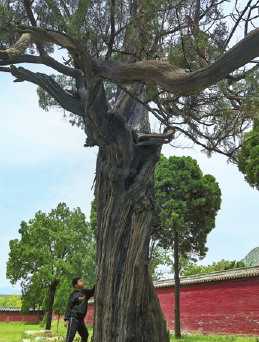GUARDIANS OF ANCIENT TREES BRIDGE PAST AND FUTURE
Preserved natural wonders enhance villagers' wealth, cultural connections

Tree healer Jin Hongjun, 55, vividly recalls the painstaking efforts to save China's beloved 4,500-year-old "General Cypress" two decades ago.
Located in the Center of Heaven and Earth historical building complex in Dengfeng, Henan province, the country's oldest cypress tree had suffered from improper care and management over the years.
Jin, from the Dengfeng cultural relics bureau, served as General Cypress' dedicated caretaker from 2004 to 2007, and talks about the ancient tree like an old friend.
In 2004, under the guidance of Professor Cong Sheng, a renowned ancient tree conservation expert, Dengfeng authorities launched a comprehensive rescue mission for the ailing cypress. The project, costing hundreds of thousands of yuan, included removal of decaying parts of the tree, sterilization, structural reinforcement and soil rehabilitation.
"The challenges were immense," Jin said. Centuries of construction debris and buried pedestals of tablets had choked the tree's roots. Workers relocated tons of stone pedestals, removed rubble, replaced soil with nutrient-rich substitutes, and installed drainage and aeration systems — a labor-intensive process requiring meticulous attention.
"Conservation isn't a one-time fix. Trees are living beings, they need sustained attention," Jin said.
Impressed emperor
The tree's historical significance dates back to 110 BC when Emperor Wu of the Han Dynasty (206 BC — AD 220) visited Songshan Mountain on an imperial inspection tour. Impressed by its majestic stature, he bestowed upon the tree the title of "General Cypress".
Centuries later, in 1750, Emperor Qianlong of the Qing Dynasty (1644-1911) created his renowned ink painting Han Dynasty Cypress at Songyang, which fetched over 87 million yuan ($12 million) at an auction in 2010.
Though local officials began protecting ancient trees as early as 1936 — when the then-magistrate Mao Rucai numbered them and installed enamel plaques — the 2004 campaign marked Dengfeng's first major investment in arboreal heritage.
Bolstered by training from the professor, Jin expanded his arboreal conservation work. By 2008, he led the protection of 878 ancient trees at the Center of Heaven and Earth's eight historic building sites, in preparation for its UNESCO World Heritage application. The center was inscribed on the UNESCO World Heritage List in 2010.
With tight deadlines and some trees in remote mountainous terrain, Jin and his team hauled equipment uphill, camped on-site, and endured nights in tents that had collapsed under heavy rain.
At Songshan Mountain's Zhongyue Temple, where there are over 330 ancient cypresses, Jin faced labor shortages. Despite battling a fever, he recruited 50 laborers and personally trained them, climbing scaffolding repeatedly to demonstrate conservation techniques. He worked through the day, and was given IV drips at night.
Wandering among the ancient cypresses, Jin's voice softened as he recalled the dry clay, which was "hard like stone". "We couldn't use machinery near the roots," he said, describing efforts to dig rejuvenation trenches by hand. "Two workers took a full day to carve out one meter."
During one Spring Festival holiday, he saw three tourists preparing to burn incense next to an ancient cypress to pray for good luck. He changed their minds by telling them "the best worship for ancient trees is to pour a few buckets of water in the dry season".
Jin said in such a harsh environment ancient cypresses grow extremely slowly.
Due to previous methods of determining tree ages being less accurate than today, some trees thought to be about 1,000 years old may actually be over 3,000 or 4,000 years old, he said.
"Ancient architecture valued the natural environment and feng shui, so temples were often built where there were ancient trees. Therefore, the ages of many ancient trees in Zhongyue Temple are likely to be seriously underestimated," he said.
In 2024, Jin's 20-year dedication to conservation earned him a spot on the National Forestry and Grassland Administration's panel of experts. He has now "healed" more than 20,000 ancient trees in provinces across the country, from Shanxi's arid plains to Fujian's humid subtropics.
His phone rings like an emergency hotline, and once his services are requested he rushes to help restore old trees.
Jin believes tree preservation is a multidisciplinary science. Besides anti-erosion treatment and structural reinforcements for hollowed trunks, Jin emphasizes microhabitat management including breathable fences to prevent soil compaction, annual flowers to enrich biodiversity, and strict bans on invasive grasses that starve roots.
"In the north, focus on hydration and aeration. In the south, drainage is key," he said. "But consistent care — judicious watering and loosening soil — is essential."
Jin stresses public awareness about arboreal care to minimize human impact on the growth of ancient trees.
"As long as people avoid harming trunks or roots, reverence for trees — expressed through rituals or worship — is a sacred tradition worthy of respect," he said.
Old growth, new wealth
The veteran arborist has acquired much of his knowledge about trees and their cultural significance from grassroots people. "By listening to villagers' stories, I learn to protect these giants in harmony with local ecosystems," he said.
Several years ago, Jin visited Leijiagou village near the Shaolin Temple to undertake protection work on several ancient Quercus baronii (a type of oak) trees growing in the crevices of rocky slopes. A small stone temple from the Qing Dynasty's Qianlong period was beneath the trees.
A shepherd aged over 80 told Jin he remembered the trees from when he was a child. The current poor state of the trees was likely due to years of soil erosion near the roots, the shepherd said.
When a sheep approached one of the ancient trees, the herder quickly shooed it away, and said to Jin: "The old tree is sacred. I don't allow sheep near it, or to even graze on its fallen leaves."
Leijiagou is at the foot of Songshan Mountain, considered sacred by many, and is home to more than 10 ancient trees, including Quercus baronii, sala trees and big leaf poplars.
Since 2015, the village has pivoted from stone mining to ecological restoration and provided accommodations for visitors. It has constructed an ecological park for the Quercus baronii trees, expanded a small pond into Mirror Heart Lake, and upgraded old cave dwellings into boutique homestays. It is now a model picturesque village in Zhengzhou city and a national forest village.
"These trees are both our historians and main attraction," said Liu Xiaohui, 33, a Leijiagou Village Committee member, and owner of Songshan Windmill Farm.
The village's annual tourist numbers now exceed 100,000, drawn by the Shaolin Temple and nature's wonders. "The village history museum undergoing construction will highlight the trees' role in local historical heritage, and attract more visitors to explore the profound culture of Songshan Mountain," Liu said.
In January, staff from the Henan Provincial Forestry Bureau visited Leijiagou and took 3D digital images of the old trees to establish a pilot ancient tree cloud museum.
As a county-level city within Zhengzhou, Dengfeng has over 7,400 registered ancient trees.
In 2021, the local forestry bureau organized teams to visit rural towns. The teams produced a mini documentary series the Sacred Charm of Ancient Trees that had 52 episodes. Authorities have also staged exhibitions and painting activities to raise awareness about protection of ancient trees.
A real family tree
Villages and temples also preserve Huai, or Chinese scholar trees, planted by Ming Dynasty (1368-1644) migrants from Hongtong county in Shanxi, said Zhao Xiaoli, director of the Dengfeng Greening Service Center.
The scholar tree is highly regarded as a symbol of ancestral roots and a witness and marker of an area's history, Zhao said.
One such tree stands in Yuanqiao village, 10 kilometers southwest of Dengfeng. The thriving tree, over 500 years, stands more than 14 meters high and spreads an 80-square-meter canopy of leaves. Historical records show Yuanqiao was founded during the reign of Emperor Hongwu (1368-1398) in the Ming Dynasty by migrant Yuan Kecheng, who had nine children and planted nine scholar trees to remind his descendants of their Shanxi roots.
The sole surviving tree is near a small bridge, built by the Yuan family who Yuanqiao village derives its name from. Almost every family in the village has the surname Yuan.
The tree's legacy also intertwines with philanthropy.
Yuan Zhanguo, 73, chairman of Dengfeng's Dengcao Group and a native of the village, wrote in an article that he recalled childhood rituals honoring the tree as a "guardian deity".
His childhood home in front of the tree now houses Henan's first village-level charity station, established in 2015 by Yuan Zhanguo and his two brothers.
It provides seniors with monthly payments of 300 to 1,000 yuan and supports scholarships. "My parents refuse my money now, the station supports them," said 55-year-old village official Yuan Jinyi.
Yuanqiao's heritage extends beyond the tree.
A 6,000-year-old neolithic site, large-scale 300-year-old courtyard houses, and a 440-year-old fortified tower coexist with Red culture sites like the first Dengfeng Communist Party of China Congress venue.
In 2017, the Yuan brothers founded the Yuanqiao Ancient Village Conservation Company. They have invested 300 million yuan to restore the old buildings, improve the ecological and living environment, build village history museums, tourism facilities, and unique rural guesthouses.
Yuanqiao was recognized as a National 3A Scenic Area and traditional village in 2022, attracting 1 million annual visitors. "Protecting and inheriting Yuanqiao's historical culture is our biggest wish," Yuan Zhanguo's younger brother Yuan Zhanxin wrote in the 2023 book, The Story of Yuanqiao. "This isn't a quick-profit industrial project, but a legacy that will benefit generations a century from now," he wrote.
Rural gems
On Jan 25, the State Council, China's Cabinet, released the Regulations on Ancient and Notable Tree Protection, to take effect on March 15. The policy aims to safeguard these natural treasures, integrate their cultural value into festival culture and historic villages, and boost eco-tourism — a vision already realized in Leijiagou and Yuanqiao villages.
However, Dengfeng's rural gems hold untapped potential.
Donghua Town was a trade hub during the Qin Dynasty (221-206 BC) and is nestled between the Funiu Mountains and the Yinghe River, the biggest branch of the Huaihe River.
Today, the town is home to 84 ancient trees and a dozen heritage sites like the tomb of Xu You (a sage who lived over 4,000 years ago), the Cheng Kiln site (neolithic to Bronze Age relics), and the Zhouzhuang village's temple stone carvings.
The latter features seven Ming-Qing stone tablets detailing the Buddhist-Taoist Zhuyuan Temple's expansions since the 16th century and its close ties to Shaolin Temple. A scholar tree more than 500 years old stands nearby.
Zhouzhuang blends its ancient temple with bamboo groves, old watchtowers and reservoirs, railway tracks and pastoral landscapes. In spring, its rapeseed blooms and temple fairs draw crowds, while the restored temple and improved transportation and infrastructure reflect the grassroots efforts to improve the village's amenities.
Village Party secretary Zhang Haoran, 27, is a former military member-turned rural revitalizer. His plans include upgrading waste management and transforming abandoned traditional dwellings near the ancient scholar tree into boutique homestays.
"The tree witnessed my growth and the village's centuries of history. I passed by it daily as a child," Zhang said.
"Several entrepreneurs have come to inspect the construction of waterslides and sightseeing trains. We welcome investors to develop eco-cultural tourism projects, our goal is to preserve heritage while ensuring investors are satisfied."





Today's Top News
- China commissions CNS Fujian in Hainan province
- Xi attends commissioning of China's Fujian aircraft carrier
- Xi congratulates Paul Biya on re-election as president of Cameroon
- Thai king to pay state visit to China
- Mars orbiter snaps images of interstellar object
- Gold VAT trade reform to bring healthier order






























